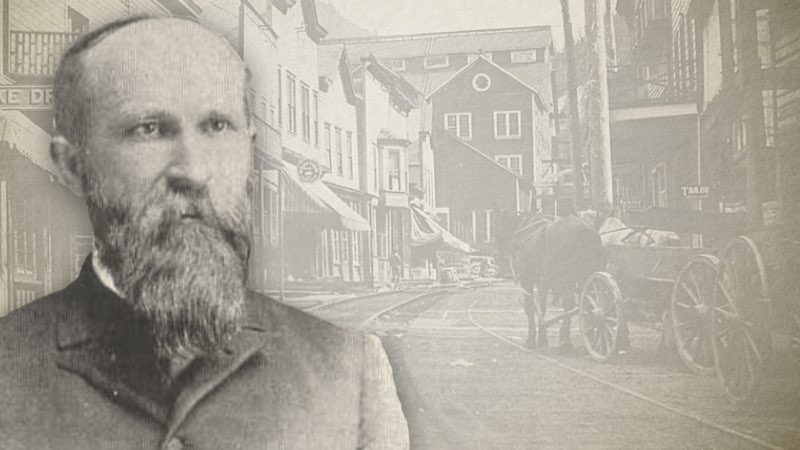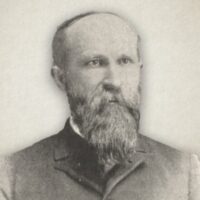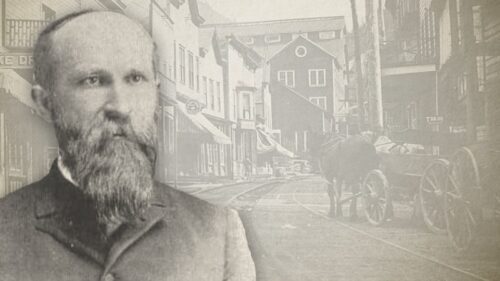
Chapter 8: Waldensean Period (Continued)
A.D. 500
ANABAPTISTS.—In the year A. D. 500, we find Anabaptists existing in France and Spain. ”In the language of councils at this period, Christians are denominated, either from their opinions, heretics, or with a view to their discipline, schismatics; but there was one article of discipline in which they were all agreed, and from which they were frequently named, and that was BAPTISM. They held the Catholic community not to be the church of Christ; they therefore rebaptized such as had been baptized in that community, before they admitted them to their fellowship. For this conduct they were called Anabaptists.”
There never has existed any fellowship between Baptists and Catholics, but on the contrary, an obstinate declaration and refusal upon the part of each to recognize the other as being a church of Christ. The Catholics have always regarded Baptists as being their only foe.
DONATISTS.
While the Anabaptists were found in France and Spain, the Donatists continued to exist in Africa, and we find them Buffering the most severe persecutions at the hands of the Catholics, from A.D. 534 to 750, when they disappeared from Africa and probably went to Spain or Italy. During all this period of more than two hundred years of persecutions, they remained a separate body of Christians, and possessed their own churches. Under the severe persecutions to which they were subjected, they tried every means to foster and advance their interests, but Pope Gregory made them the special objects of his invectives, and wrote to the African bishops, requiring them to exert themselves in every way to suppress the Donatists. These efforts to subject them, and to destroy their congregations, forced the Donatists to meet for worship in dens and caves of the mountains, and for this reason they were sometimes known by the name Montenses, i.e. mountaineers. They so continued, says Mr. Orchard, until the middle of the eighth century, when they disappeared and carried the gospel light into other countries. Africa had, through these instrumentalities, been blest with a pure gospel for five hundred and fifty years, as the Donatists were first found, as has already been shown, by the name of Montanists, at Carthage, in A.D. 200. Donatus became a leader among the Montanists in A.D. 300, when they took his name which they continued to bear until A.D. 750, a period of four hundred and fifty years.
The Donatists, as has already been shown, held to the same principles which characterize Baptists today. During all this period of time, Christians holding to the same faith were found in France, Spain and Italy. They were known by the names, Novatians, Paterines and Puritans, and sometimes by the term Cathari, which means, the pure. Of these people it may be truly said, “The world was not worthy,” and the sacrifices, toils and deprivations to which they were subjected, should make Baptists of the present day blush with shame at their own self-sacrifice and illiberality.
PAULICIANS.
A.D. 653. In the year 653, a sect arose in the East which was known by the name of Paulicians. There resided in the city of Mananalis, a city in Armenia, an obscure person by the name of Constantine, through whom the Christians, known by this name, originated. On one occasion Constantine entertained at his house, for several days, a stranger who was a deacon. This Christian man had been a prisoner among the Mahometans, and was returning to his home in Syria, from whence he had been carried away captive. Constantine received from this stranger a copy of the New Testament, in the original language. This was several hundred years before the art of printing had been discovered, and copies of the New Testament were not only rare but very costly. Beside this the common people had been discouraged from reading the Bible. They said, “It is not lawful for us profane persons to read the sacred writings, but for priests only.”
Owing to this fact, and the great state of ignorance prevailing at that time, the common people were almost wholly unacquainted with the sacred writings. Constantine, however, applied himself most assiduously to the study of the New Testament, and especially, says Mr. Jones, to the writings of the Apostle Paul, from which he endeavored to deduce a system of doctrine and worship. The mind of Constantine having become enlightened by the simple truths of the Bible, he went to work at once to impart them to others around him. The result was that a considerable number of persons professed the same faith. In a short time several individuals were found, among this class, who were qualified for the Christian ministry, and, as a result, several churches were established throughout Armenia and Cappadocia. These Christians, from having derived their principles of doctrine and church polity principally from the writings of the Apostle Paul, were called Paulicians.
Constantine himself was known by the name Sylvanus, and others, of his fellow laborers, were known by the names of Timothy, Titus, etc.
These Paulicians were at once distinguished for their zeal, piety and the austerity of their lives. The simplicity of their doctrines commended them to the common people, and consequently, “In a little time,” says Orchard, “congregations were gathered in the provinces of Asia Minor, to the westward of the river Euphrates. Their opinions were also silently propagated in Rome, Milan, and in the kingdom beyond the Alps, (France).” The same writer says the whole body of Christians in Armenia, came over to the Paulicians and embraced their views. Their churches were modeled as nearly after the New Testament churches as it was possible, and even named for them in many instances. It is recorded that six of them were named from those to whom the Apostle Paul addressed his epistles, viz: Home, Corinth, Ephesus, Philippi, Colosse and Thessalonica. The Paulician teachers were distinguished, only by their Scriptural titles. The Paulicians were sometimes denominated ACEPHALI, or headless, from the fact of their having no bishop, in the Romish sense of the term.
Alarmed at the rapid growth of the Paulicians, the Catholic party, true to the principles of their faith, begun to inflict upon them the most severe persecutions.
“A Greek officer, named Simeon, armed with legal and military authority, appeared at CORONIA to strike the shepherd, Sylvanus, and to reclaim, if possible, the lost sheep. By a refinement of cruelty, this minister of Justice placed the unfortunate Sylvanus before a line of his disciples, who were commanded, as the price of their pardon, and as proof of their penitence, to stone to death their Spiritual Father. The affectionate flock turned aside from the impious office; the stones dropped from their filial hands; and of the whole number, only one executioner could be found. This apostate, Justus, after putting Sylvanus to death, gained by some means, admittance into communion, and again deceived and betrayed his unsuspecting brethren; and as many as were treacherously ascertained, and could be collected, were massed together into an immense pile, and by order of the emperor consumed to ashes. Simeon, the officer, struck with astonishment at the readiness with which the Paulicians could die for their religion, examined their arguments, and became himself a convert, renounced his honors and fortune, and three years afterwards went to Cobossa, and became the successor of Constantine Sylvanus, a zealous preacher among the Paulicians, and at last sealed his testimony with his blood. To free the East from those troubles and commotions, said to arise from the Paulician doctrines, a great number of them were transported [A.D. 692.] to THRACE during this century; but still a greater number were left in Syria and the adjoining countries. From Thrace these people passed into Bulgaria and Sclavonia, where they took root, and settled in their own church order.”
Mr. Orchard, the writer quoted above, says, that from the blood and ashes of the first Paulician victims, a succession of teachers and congregations arose, and the great instrument of the multiplication of this people was their loyalty to the teachings of the New Testament. One Sergius was induced by a Paulician woman to read Paul’s writings, and his attention to these epistles brought him to embrace their views. As a result, for thirty-four years he devoted himself to the preaching of the Gospel. So it has ever been, and ever will be, when people go to the New Testament to settle their doctrinal views, they become Baptists.
But were the Paulicians Baptists? A summary of their doctrinal views will answer the question. We have seen:
First. They took the New Testament alone for their guide in doctrinal matters and church polity.
Second. They had no bishops in the Romish sense, but simply pastors.
Third. They denied that baptism and the Lord’s Supper were sacraments. Mosheim, vol 1, p. 295, says, “They rejected baptism, and in a more especial manner, the baptism of infants, as a ceremony that was in no Respect essential to salvation. They rejected, for the same reason, the sacrament of the Lord’s Supper.” Baptists regard Baptism and the Lord’s Supper as ordinances and not sacraments.
Fourth. They opposed infant baptism. (As the identity of the Paulicians and Albigenses is established in the discussion of the Albigenses, see pages 81, 82, for proof of this proposition.)
Fifth. They owned no head, or Lawgiver, but Christ. For this reason they were called ACEPHALI, the headless.
Sixth. Their churches were independent organizations.
Seventh. They opposed sacraments of every kind, and all ritualistic service.
These principles characterize no other people than the Baptists. All the information which can be obtained concerning the Paulicians, has been obtained from their enemies, who endeavored to put them in the worst light possible. As has already been noted, the Paulicians originated in A.D. 650. They continued by the same name four hundred years, or until 1050, when they were so scattered by persecutions that they were no longer known by this name. “It is however certain,” says Mosheim, vol. 1, p. 294, “from the most authentic testimonies, that a considerable number of that sect were, about the middle of this (the eleventh) century, settled in Lombardy, Insubria, and principally at Milan, and that many of them led a wandering life in France, Germany and other countries, where they captivated the esteem and admiration of the multitude. In Italy, they were called Paterini and Cathari, or rather Gazari, which latter appellation the Germans have preserved with a small alteration only, which was proper to adapt it to the genius of their language. In France, they were called Albigenses, from the town of Albi, and Bulgarians because they came from Bulgaria, and because the head of their sect resided in that country; as also Publicans, which was probably a corrupt pronunciation of Paulicians, and boni homines, or ‘good men,’ with several other titles and epithets.” These names have characterized Baptists throughout the dark ages, and especially the successors of the Novatians. ”All these branches, however,” says Jones, ”sprang from, one common stock, and were animated by the same religious and moral principles.”
Author of the “Compendium Of Baptist History”. Please inform the Editor of the AHB (via the Contact page) if you have biographical information on this author. Thank you.
Shackelford on Baptist History (Complete)




